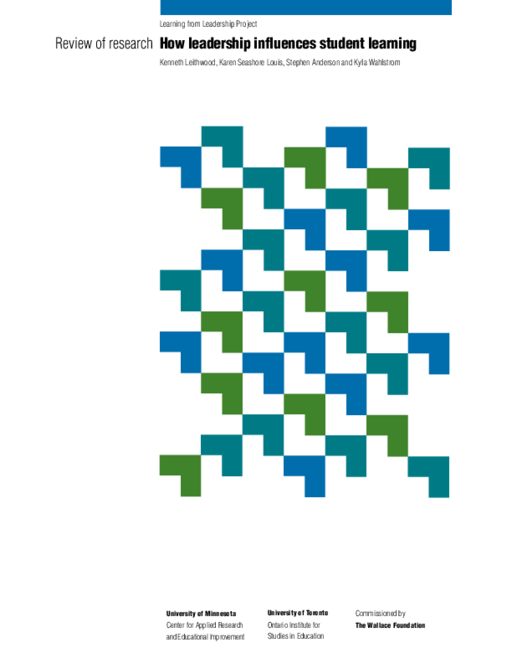- Author(s)
- Kenneth Leithwood, Karen Seashore Louis, Stephen Anderson, and Kyla Wahlstrom
- Publisher(s)
- Center for Applied Research and Educational Improvement
Research Approach
The authors reviewed the existing literature on school and district leadership and its impact on student achievement and practices linked to improved student achievement. They used a framework which emerged from empirical research in sociology and in organizational and industrial psychology.
The framework assumes that variation in workplace performance (e.g., the effectiveness of teachers in their classrooms) is a function of the capacities (e.g., instructional skills), motivations and commitments of workplace personnel, the characteristics of the settings in which they work (e.g., schools, districts) and the external environment (shifting state policies and other demands). According to this framework, leaders play critical roles in identifying and supporting learning, structuring the social settings and mediating the external demands.
Variations of this framework have been used in education contexts to understand better how schools and districts respond to state accountability policies and to explain variations in the success with which schools implement and incorporate new policies and practices. A significantly expanded version of this framework, summarized in Figure 1., serves as the organizer for this review of literature. According to Figure 1, features of both state (variable 1) and district (var. 2) leadership, policies, practices and other characteristics interact with one another and exert a direct influence on what school leaders do (var. 4); they also exert influence on school (var. 6) and classroom (var. 8) conditions, as well as on teachers’ professional community (var. 7). Other stakeholder groups (var. 5), such as the media, unions, professional associations and community and business groups, also have influence on school leadership practices, as do leaders’ professional learning experiences (var. 9).
Student and family background factors (var. 3) have a significant bearing on most other variables and relationships in this framework. For example, they sometimes influence how school leaders do their work; the nature of classroom teaching and learning processes (through their effects on teachers’ expectations); the financial resources available to districts and schools; and the nature of the “social capital” available to students.
School leadership (var. 4) from both formal and informal sources helps to shape the nature of school conditions (var. 6) such as goals, culture, structure and classroom conditions (var. 8) – the content of instruction, the size of classrooms, the forms of pedagogy used by teachers, etc. A wide array of factors, including those in the school and classroom, help shape teachers’ sense of professional community (var. 7). School and classroom conditions, teachers’ professional community and student/family background conditions are directly responsible for the learning of students (var. 10).

